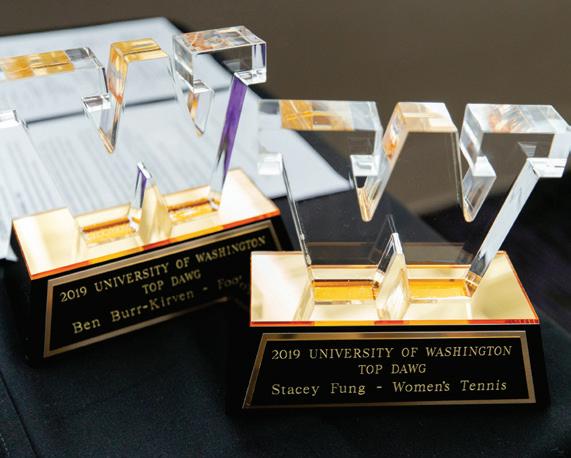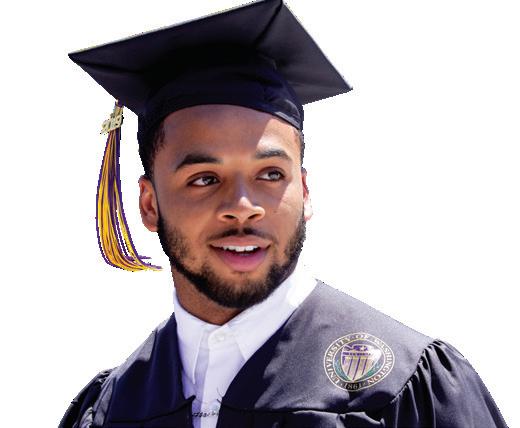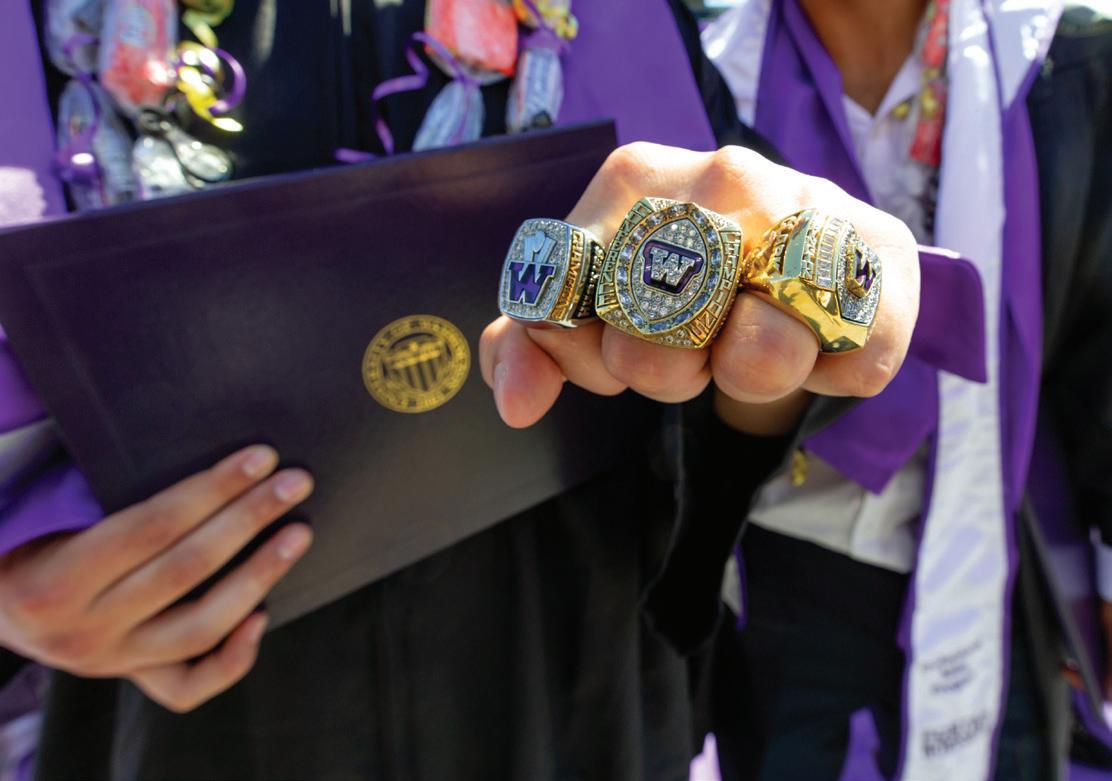
16 minute read
It’s still Championship Season for UW Academic Services
THE TEAMA “ ” Athletic competition may have stopped, but the action has never been more intense for Washington’s Student-Athlete Academic Services
BY BRIAN BEAKY O ver the past two months, thousands of Americans nationwide have found themselves taking on a new role as teacher or tutor different classes, each one with its unique method of conducting distance learning, as determined by its professor. EDITOR • GOHUSKIES MAGAZINE to students conducting all of their schoolwork at home. From managing If you can't imagine that — well, lucky you. If you can, then you're probably Zoom schedules, to creating calendars of assignment and project deadlines, Kim Durand, or one of the many hard-working tutors and support staff working to helping children understand lessons and complete their homework — all in the UW's Student-Athlete Academic Services department. while trying to communicate with similarly overburdened teachers — the In a normal quarter, Durand's job is a busy one. As UW's Senior Associate process has led many parents to express their exasperation on social media Athletics Director for Student Development, Durand is the chief administrator platforms, and created a newfound or increased appreciation among parents of all things related to the "student" in student-athlete. That includes for the day-to-day efforts of those responsible for educating our children. everything from career and academic counseling, tutoring and registration,
Imagine, then, being responsible for coordinating the learning of not to long-term planning and the complex task of coordinating student-athletes' one or two students, but more than 600. Spread across nearly all 50 states travel and practices with lectures and tests. and multiple international locations. And, jointly, attending more than 1,000 This quarter has been anything but normal.

Durand says that the initial announcement from the University of Washington canceling all in-person classes occurred during the final week of the winter quarter, just as students were preparing to take finals. Shortly thereafter came the NCAA's decision to cancel all winter and spring sports championships, followed two days later by the Pac-12's decision to cancel all sports through the end of the year. With no reason to keep students on campus, and many planning to travel home for spring break anyway, department staff determined that the safest place for most of Washington's student-athletes would be to remain at home until the situation in Western Washington was more stable. "Many of our student-athletes were traveling home to places that weren't as hard-hit, so once it was determined that spring quarter was going to be online, we suggested that the safest thing for them to do was to stay put," Durand says. "The truth is that the changes were happening so rapidly. It's definitely required a lot of quick decisions and problem-solving and figuring things out as we go along."
That first decision — to keep students at home — created the first problem, one that will be familiar to any parent of a school-aged child in the coronavirus era: not all homes are created equal. Many student-athletes were returning to homes with limited access to technology, weak or nonexistent Internet service, or a competition for resources between parents working from home, siblings needing to use home computers for their own schooling, and the student-athletes themselves. "One of the first things we had to do was to purchase a bank of laptop computers and hotspots, that we sent all over the world," Durand says. "Our IT staff did an incredible job procuring those resources at a time when there weren't many in the supply chain. We also had to go to students' dorm rooms to gather belongings and other resources that they might need, and ship those to them as well."
As it turned out, that was the easy part. Once students had the resources they needed, Durand and her SAAS staff dove into the complex web of Zoom meetings, recorded lectures, digital classroom platforms and other services being offered by thousands of different professors and teaching assistants. Furthermore, each of Washington's 600-plus student-athletes have not only a unique schedule, but also unique learning support needs, making an already complicated system almost infinitely complex.
Durand and her staff dove in headfirst.








"Obviously, professors were given a ton of autonomy to run their classes how they saw fit, so every class is different. We have everything from typical Monday-Wednesday-Friday classes where students log into a Zoom lecture, to others where the lectures are recorded and students watch them on their own time and turn in assignments. And, of course, our job was to figure out how each class for each student was being taught, and how to help students plan for those lessons."
That job would be hard enough if every student was living on or near campus. Instead, though, Washington currently has students sheltering in place in countries all over the world, meaning that Durand and her staff had to not only create specific learning support plans for each class, but for each student in each class, taking into account time zones, technological resources of that student, potential language barriers and more. "We were literally going through thousands and thousands of classes individually, then figuring out specific plans for each student-athlete, and how we can best meet their needs," Durand says. "And then, once we had a specific plan for each student, we had to coordinate all the tutoring and academic meetings that we would usually have on a weekly basis," she continues. "My staff are still going 10-12 hours a day, just because of all the extra logistics required by this virtual learning model. It's been hard, but our staff are incredibly committed to our studentathletes' success, and our student-athletes are very resilient. We're all hanging in there."
Durand's staff, of course, have not been working alone in their efforts. In addition to the IT staff that procured computers for at-need students, and marketing and digital staff working to create engaging experiences for student-athletes to connect and engage with one another, the Huskies' coaching staffs have been essential partners in the process, proving that they are just as committed to earning "A"s as "W"s. "Our coaches have been unbelievable with all of this," Durand says. It feels like we have quadrupled our academic staff because of all of the coaches who have taken it upon themselves to monitor study tables over Zoom for hours with their teams, check in individually on academics with their student-athletes, or otherwise provide academic support. Everyone has shown an incredible commitment to making sure that this is as positive an experience as it can be for our student-athletes."
Indeed, Durand suggests that while, certainly, no one would have chosen to put themselves into this position, there may be some positives that will come out of it. Many student-athletes, she says, have been able to take classes that they otherwise wouldn't have been able to take because of practice or competition schedules, while some have been able to use this time to knock out more difficult courses now that they find themselves with more time to dedicate to schooling. In addition, Durand says that the success of online instruction may prompt the University to create more online offerings in the future, making it easier for student-athletes to balance their academic and athletic schedules.

Durand may even make changes to the way SAAS conducts tutoring, based on the experience the staff and student-athletes are gaining with digital offerings. "In the past, it was standard policy that if you were on a road trip, you just didn't have tutoring that week," she explains. "But now, as we start thinking about this, we can envision a future where we set up a remote tutoring program, so that students can be in a meeting room or a hotel room on the road and engage directly with a tutor online. It's really helped us rethink our mindset and come up with creative solutions."
With the NCAA's decision to cancel the spring sports season came an announcement that all spring sports athletes in their final competitive seasons would receive a bonus year of eligibility. Approximately 10 student-athletes have made the decision to enroll in UW graduate programs next year — a higher number than usual, Durand says — while others will have the option to take post-baccalaureate classes and pursue a second major or minor, or finally take those interesting classes they could never quite fit into their degree plan.
And, while those students who will be graduating — including the falland winter-sports seniors, and those spring-sports seniors who have elected not to return in 2020-21 — will not have the opportunity to don a cap and gown and walk across the stage at Husky Stadium with their classmates (at least, not until 2021, when 2020 graduating seniors will be invited back to participate in the ceremony), the athletic department staff have planned a virtual graduation banquet and ceremony that Durand hopes will give those deserving graduates a sense of the accomplishment they've achieved. First, the department will live-stream a virtual version of the annual athletic department graduation reception, at which graduates usually gather with their families to hear from speakers and receive awards, and generally celebrate their success. In addition, graduates will be sent a care package including awards, programs, any sashes that graduate earned, signs to put in their yard, and more. "We're calling them 'graduation parties in a box,'" Durand says. "The virtual grad reception will give student-athletes all over the world the chance to log in and be celebrated, while we'll also being using our website, GoHuskies.com, to tell graduates' stories and feature their accomplishments. In our department, this is our National Championship Day, and that's what we want it to feel like for our graduates."
Ultimately, Durand says that while the process of transitioning 600 student-athletes spread across all corners of the planet to distance-learning has been difficult, it's highlighted many of the qualities that make her proud to be a Husky. "I think that, throughout the department, there's a renewed sense of our core values around educating these young men and women at a world-class university," she says. "In these difficult times, you've really seen a lot of people step up, and show an incredible work ethic. Our student-athletes feel appreciated and cared for. Everybody is pulling in the same direction, and that just shows the true heart of this department that I'm so proud to be a part of."



Making The Grade


Husky football’s recently-announced four-year APR of 999 is the highest in NCAA FBS history
he Washington football team has earned a four-year NCAA Academic Progress Rate of 999 (out of a possible 1,000) for 2018-19, the highest four-year score ever by an NCAAT FBS football program, the NCAA announced earlier this month.
The UW football team's score (full APR totals for all other NCAA sports were released after this issue went to print) was the highest in the nation for the 2018-19 year, and was one point better than the previous high by an FBS program (998, Wisconsin, 2013-14). "I could not be more proud of our football program for today's NCAA Academic Progress Report release," said Jennifer Cohen, UW's director of athletics. "To post the highest-ever recorded four-year mark among FBS programs speaks volumes about our students, football coaches and staff's commitment to continued excellence in the classroom at the University of Washington."
In 2004, the NCAA created the APR to measure academic progress and retention — not solely graduation rate. The scores represent a four-year rolling average from the academic year 2015-16 through 2018-19.
In this year's rating, Washington was one of 13 football programs that earned a score of 988 or higher, the standard for APR recognition from the NCAA. The Huskies' 999 placed the UW atop the Pac-12 for the third year in a row. Washington has earned APR recognition from the NCAA in each of the last four years.
The UW football team's score of 991 in last year's ranking was the highest in program history prior to this year's 999. Prior to this year, no Pac-12 football program had ever scored higher than 995 (Stanford, in 2004-2005). "I'd especially like to acknowledge Kim Durand [senior associate athletic director for student development] and her team for their tireless work to support our students' academic endeavors," Cohen added.



UP TO PAR

Washington's men's golf team wrapped up one of its most impressive seasons in program history — just a little sooner than they expected
Head coach Alan Murray O n a rainy Wednesday in early September, the UW men's golf team teed off for their first collegiate competition of the 2019-20 season. The Huskies hosted a deep field of talented golfers in Bremerton at the Gold Mountain Golf Club. The conditions Husky Invitational.
Twenty-four hours later, Noah Woolsey and Jan Schneider hoisted the did a great job of playing with the games we had that week, a real challenge individual winner trophy in a four-way tie with two other golfers and the Dawgs for players even at the highest level.” began a scorching-hot season in which they claimed four more tournament Despite a rocky few rounds, the Dawgs still took home first place and the wins and soared up the national rankings to 11th place. confidence appropriate for one of the best teams in collegiate golf.
But, before that damp Wednesday in September that started the Huskies' Another test was up next for the Dawgs, as they traveled to North Carolina dominant season, head coach Alan Murray changed up his preseason tactics to compete at top-ranked Wake Forest in the Old Town Intercollegiate. by taking the team on an international training trip in August. “We had good players playing well and the course set up nicely for this
“The Ireland trip was pretty key in terms of the guys going to a strange group,” says Murray. “It was obvious making birdies was required to win the place as a group,” explains Murray. “And, for many of them, they were playing tournament and our guys made a lot of birdies.” a completely new style of golf in less than perfect conditions.” Sure enough, at Wake Forest’s tournament the Huskies scored the second
The difficult golfing and challenging conditions provided a valuable most birdies of all the teams in the competition, with 52, and the most eagles, experience for the team. But, the greatest benefit from the trip may have been with three. Woolsey finished the tournament with a field-leading two eagles bonding as a group with many loyal Husky golf supporters that joined the and fourth-best 13 birdies. Dawgs overseas. “They did a great job of taking advantage of the holes they could be more
“I have to make a special word of mention about our donors that participated aggressive on,” says Murray. “Wake Forest is obviously a really good team, so on the trip,” says Murray. “They were such good company, shared their stories to beat them on their home course gave our guys even more confidence.” and our guys really saw up close what Husky golf means to so many people. It After the third tournament of the season, the Maridoe Intercollegiate, was a lot of fun for everyone that was on the trip and it put us in a relaxed, but where the Huskies finished eighth, they placed in the top three in each eager, state of mind heading into our season.” tournament remaining on their schedule.
With plenty of challenging golf, poor weather and great memories from “We have good players. They showed that all year long by how they Ireland under their belts, the Dawgs returned to Washington to host the played,” says Murray. “Every guy got better, which is really important as it
“Improving at anything in life is going to involve struggle and coming to terms with the challenge of tasks not being straightforward and easy,” explains Murray. “Having that experience from the Ireland trip prior to the first tournament was really beneficial. BY JACK LARKIN were sub-par, and the course was one of the hardest in Washington state. “We didn’t play our best at the Husky, but we were mentally focused and
Jan Schneider

pushes everyone on the team.”
What really pushed this team to reach their potential was the internal competitiveness of the student-athletes.
“We have a healthy competitive rivalry on the team and every spot is up for grabs, in a sense,” explains Murray. “The guys knew that if they were the low man on the team each week, then there was a great chance they would be battling for the individual title.”
After the Maridoe Intercollegiate, the Huskies claimed first at the Georgetown Intercollegiate, second at the Ka’anapali Collegiate, third at the Arizona Intercollegiate, first at the Seminole Intercollegiate, and second at the Bandon Dunes Championship.
Looking back on the years past leading up to this season, it’s nearly impossible to imagine the widespread success of the Huskies this season, even for coach Murray.
“I felt that we would be an extremely competitive team and on a good day be a handful for anyone,” says Murray. “But, when you look at the statistics from our season and how well the guys played, I think that it would be a stretch to say that I expected that.
“Competitive golf is extremely hard, but our guys did an unbelievable job of preparing and competing to a very high level.”
Even though their historic season was cut short, there is plenty for the Husky golf team to celebrate.
“This was one of the best years in the program's history, which is filled with success, and though it was cut short, and as disappointing as that is, I think our guys know what they are capable of,” says Murray. “With continued intelligent hard work in the future, they can continue to improve and accomplish even more.”






